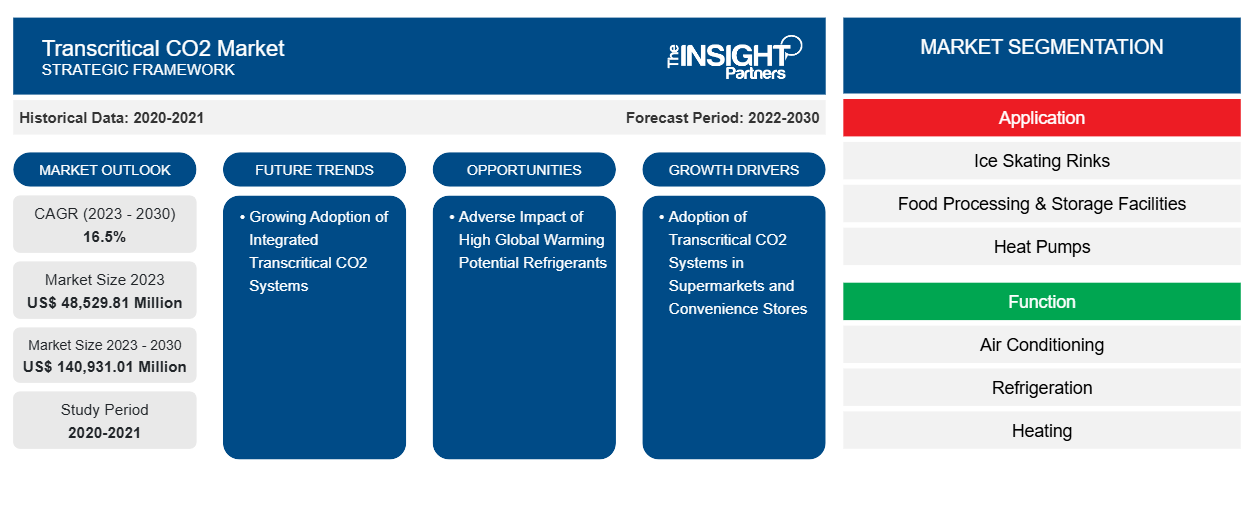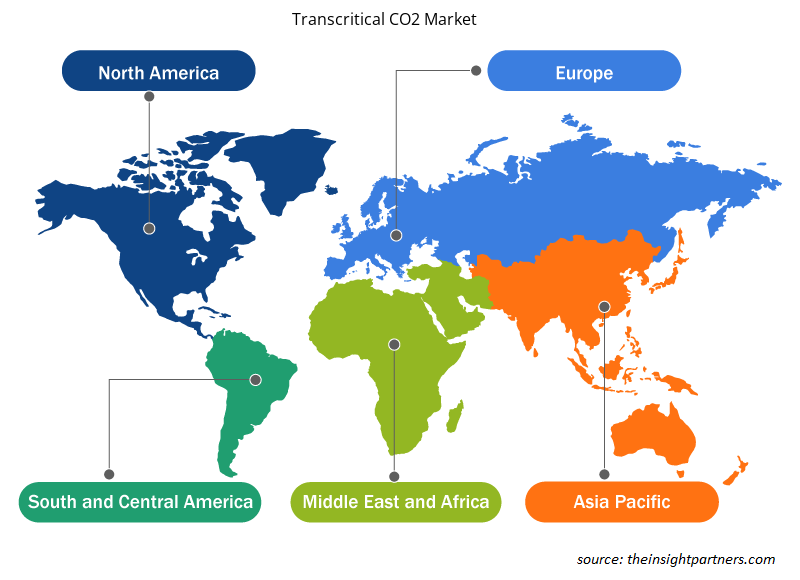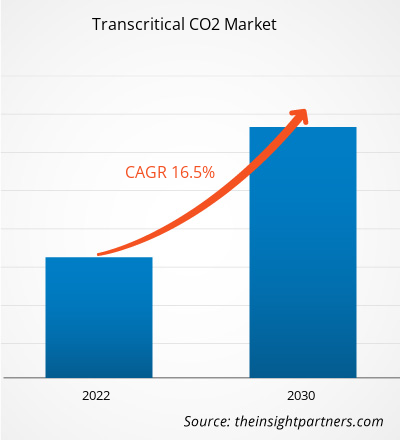Le marché du CO2 transcritique devrait atteindre 156,99 milliards de dollars US d'ici 2031, contre 54,15 milliards de dollars US en 2024. Le marché devrait enregistrer un TCAC de 16,8 % entre 2025 et 2031. L'utilisation du CO2 recyclé à partir de déchets dans les applications de réfrigération devrait apporter de nouvelles tendances au marché dans les années à venir.
Analyse du marché du CO2 transcritique
Les systèmes au CO2 transcritique sont principalement adaptés aux installations de stockage frigorifique, offrant un refroidissement constant avec un impact environnemental réduit. La croissance rapide du secteur de la chaîne du froid, stimulée par une demande croissante de produits surgelés et périssables, est un facteur majeur de la nécessité de ces systèmes à des fins de refroidissement. Les innovations apportées aux systèmes au CO2 transcritique ont permis de surmonter certains défis passés, tels que leur inefficacité à des températures ambiantes élevées. Des développements tels que la technologie des éjecteurs et la compression parallèle ont amélioré les performances des systèmes transcritiques dans les climats plus chauds, propulsant leur application dans le monde entier.
Aperçu du marché du CO2 transcritique
Le marché du CO₂ transcritique repose sur l'utilisation du dioxyde de carbone (CO₂) comme réfrigérant dans les systèmes transcritiques. Un système au CO₂ transcritique fonctionne au-dessus de la pression critique du CO₂, ce qui le rend extrêmement efficace dans des applications telles que la réfrigération et le chauffage. Ces systèmes gagnent en popularité grâce à leur respect de l'environnement, leur rentabilité et leur conformité réglementaire, ce qui les oriente vers l'élimination progressive des réfrigérants synthétiques à fort potentiel de réchauffement climatique (PRG). Dans un contexte d'urbanisation croissante dans les régions en développement comme l'Asie-Pacifique, l'Afrique et l'Amérique du Sud, la pénétration croissante des supermarchés en Inde et au Brésil crée une opportunité significative pour l'adoption de systèmes au CO₂ transcritique. Les gouvernements de ces régions adoptent également des politiques environnementales encourageant l'utilisation de réfrigérants naturels. Au-delà de la vente au détail et de l'agroalimentaire, des secteurs comme l'industrie pharmaceutique, l'industrie chimique et les centres de données utilisent des systèmes au CO₂ transcritique pour leurs besoins de refroidissement.
Vous bénéficierez d'une personnalisation gratuite de n'importe quel rapport, y compris des parties de ce rapport, ou d'une analyse au niveau des pays, d'un pack de données Excel, ainsi que de superbes offres et réductions pour les start-ups et les universités.
Marché du CO2 transcritique : perspectives stratégiques

-
Obtenez les principales tendances clés du marché de ce rapport.Cet échantillon GRATUIT comprendra une analyse de données, allant des tendances du marché aux estimations et prévisions.
Moteurs et opportunités du marché du CO2 transcritique
Augmentation de la demande de climatisation écoénergétique dans les centres de données en Amérique du Nord et en Europe
Le nombre croissant de centres de données profite au marché du CO₂ transcritique. Compte tenu de la consommation énergétique importante liée à leur exploitation, les ingénieurs concepteurs doivent proposer des systèmes de climatisation fiables et économes en énergie pour ces installations. L'Europe bénéficie d'une forte présence d'un secteur florissant de centres de données, avec des pôles majeurs comme Francfort, Londres, Amsterdam, Paris et Dublin. Les marchés émergents comme Milan, Varsovie et Berlin connaissent également une expansion rapide. Face à la dépendance croissante aux services numériques, les centres de données deviennent l'épine dorsale de l'économie numérique européenne. Interconnectés par des réseaux robustes, ces hubs de données facilitent un accès fluide à Internet, soutenant ainsi les opérations de divers secteurs cruciaux, tels que la médecine, les sciences de la vie et la banque. Les opérateurs de centres de données de la région accordent de plus en plus d'importance au développement durable, sous l'impulsion de réglementations européennes strictes sur les émissions de carbone. Aux États-Unis, le Texas est devenu l'un des pôles de centres de données en pleine croissance, grâce aux activités notables des opérateurs hyperscale. La région de l'Ouest des États-Unis se positionne comme un marché développé pour les centres de données, hébergeant toutes les grandes entreprises telles que Meta (anciennement Facebook), Google et Microsoft dans des emplacements majeurs tels que l'Idaho, l'Oregon, la Californie et l'Utah.
En mars 2024, Carrier a lancé les refroidisseurs à vis refroidis par air AquaForce 30XF, dotés d'un système de free cooling hydronique combiné à des variateurs de vitesse. Ils sont conçus pour offrir une efficacité énergétique allant jusqu'à environ 50 %, spécifiquement pour les centres de données. Les réfrigérants utilisant des HFC sont utilisés dans certains équipements de centres de données, notamment les climatiseurs de salles informatiques (CRAC), les refroidisseurs et certains systèmes de refroidissement en rangée. Plusieurs grands exploitants de centres de données s'efforcent de réduire leur dépendance aux refroidisseurs et ont adopté des stratégies de free cooling, qui utilisent des centrales de traitement d'air et de l'air frais comme alternatives. Les réfrigérants sont couramment utilisés dans les centres de données d'entreprise pour soutenir les centres de données hyperscale et les centres de données des fournisseurs de services dans les climats plus chauds où le free cooling n'est pas pratique. Les réfrigérants naturels sous forme de CO2 sont largement utilisés dans les systèmes de refroidissement industriels et commerciaux. Ainsi, la demande croissante de systèmes de climatisation et de refroidissement économes en énergie stimule le marché du CO2 transcritique.
Importance croissante des réfrigérants au CO2 dans les industries agroalimentaires et pharmaceutiques
Dans l'industrie agroalimentaire, les réfrigérants sont principalement utilisés pour maintenir une température contrôlée afin de préserver les produits alimentaires et les boissons. Aux États-Unis, la demande de produits alimentaires transformés, en conserve et faciles à préparer augmente avec l'urbanisation croissante, la hausse des revenus disponibles et un mode de vie actif. De plus, leur goût et leur facilité de préparation les rendent populaires auprès des jeunes. Les aliments en conserve ou prêts à consommer nécessitent des installations de stockage adaptées pour conserver leur saveur. Mal conservés, les aliments transformés risquent fortement de pourrir en quelques jours ou semaines. Une température optimale et des conditions de stockage adéquates sont essentielles pour prolonger la durée de conservation des aliments transformés ou en conserve, ce qui entraîne une demande accrue de réfrigérants. Ainsi, les supermarchés et les commerces de proximité ont généralement un impact environnemental important en raison de leur dépendance aux systèmes de réfrigération pour le stockage des denrées périssables. L'importance croissante du développement durable et de la responsabilité environnementale souligne la nécessité de réduire l'empreinte carbone et les émissions de gaz à effet de serre associées à ces systèmes de refroidissement. La nécessité d'abandonner les réfrigérants à fort PRG constitue donc une opportunité de croissance pour les fournisseurs de systèmes au CO2 transcritique. Dans la mesure où les systèmes CO2 transcritiques contribuent à atténuer l’impact environnemental lié aux réfrigérants conventionnels et s’alignent sur les objectifs de durabilité, la demande de solutions durables continuera également de bénéficier au marché du CO2 transcritique à l’avenir.
Analyse de segmentation du rapport sur le marché du CO2 transcritique
Les segments clés qui ont contribué à l’élaboration de l’analyse du marché du CO2 transcritique sont l’application et la fonction.
- En termes d'applications, le marché est divisé en patinoires, installations de transformation et de stockage des aliments, pompes à chaleur, supermarchés et commerces de proximité, entre autres. Ce segment a dominé le marché en 2024.
- Par fonction, le marché est divisé en trois catégories : climatisation, réfrigération et chauffage. Le segment de la réfrigération a dominé le marché en 2024.
Analyse des parts de marché du CO2 transcritique par zone géographique
Le marché du CO2 transcritique est segmenté en cinq grandes régions : Amérique du Nord, Europe, Asie-Pacifique (APAC), Moyen-Orient et Afrique (MEA), et Amérique du Sud et centrale (ASA). L'Amérique du Nord a dominé le marché en 2024, suivie de l'Europe et de l'Asie-Pacifique.
Le marché du CO2 transcritique est segmenté en cinq grandes régions : l'Amérique du Nord, l'Europe, l'Asie-Pacifique (APAC), le Moyen-Orient et l'Afrique (MEA), et l'Amérique du Sud et l'Amérique centrale. En 2024, l'Europe était en tête du marché avec une part de chiffre d'affaires substantielle, suivie de l'Asie-Pacifique. De plus, l'Amérique du Nord devrait enregistrer le TCAC le plus élevé sur le marché du CO2 transcritique entre 2025 et 2031. Le marché européen du CO2 transcritique est sous-segmenté entre l'Allemagne, la France, l'Italie, le Royaume-Uni, la Russie et le reste de l'Europe. La région a connu une augmentation du nombre d'entrepôts frigorifiques. Selon l'Association européenne de l'entreposage frigorifique et de la logistique (ECSLA), l'Europe compte des milliers d'entrepôts frigorifiques d'une capacité de stockage frigorifique de plus de 60 000 m³ pour divers produits. De plus, les pays européens ont mis en place des règles et réglementations pour contrôler rigoureusement les émissions de gaz à effet de serre fluorés et de substances appauvrissant la couche d'ozone. Ainsi, avec la loi F-Gas et le plan d’élimination progressive des HFC, le marché des systèmes CO2 transcritiques en Europe devrait connaître une croissance notable à l’avenir.
Aperçu régional du marché du CO2 transcritique
Les tendances et facteurs régionaux influençant le marché du CO2 transcritique tout au long de la période de prévision ont été analysés en détail par les analystes d'Insight Partners. Cette section aborde également les segments et la géographie du marché du CO2 transcritique en Amérique du Nord, en Europe, en Asie-Pacifique, au Moyen-Orient et en Afrique, ainsi qu'en Amérique du Sud et en Amérique centrale.

- Obtenez les données régionales spécifiques au marché du CO2 transcritique
Portée du rapport sur le marché du CO2 transcritique
| Attribut de rapport | Détails |
|---|---|
| Taille du marché en 2024 | 54,15 milliards de dollars américains |
| Taille du marché d'ici 2031 | 156,99 milliards de dollars américains |
| TCAC mondial (2025 - 2031) | 16,8% |
| Données historiques | 2021-2023 |
| Période de prévision | 2025-2031 |
| Segments couverts |
Par application
|
| Régions et pays couverts |
Amérique du Nord
|
| Leaders du marché et profils d'entreprises clés |
|
Densité des acteurs du marché du CO2 transcritique : comprendre son impact sur la dynamique des entreprises
Le marché du CO2 transcritique connaît une croissance rapide, portée par une demande croissante des utilisateurs finaux, due à des facteurs tels que l'évolution des préférences des consommateurs, les avancées technologiques et une meilleure connaissance des avantages du produit. Face à cette demande croissante, les entreprises élargissent leur offre, innovent pour répondre aux besoins des consommateurs et capitalisent sur les nouvelles tendances, ce qui alimente la croissance du marché.
La densité des acteurs du marché désigne la répartition des entreprises opérant sur un marché ou un secteur particulier. Elle indique le nombre de concurrents (acteurs) présents sur un marché donné par rapport à sa taille ou à sa valeur marchande totale.
Les principales entreprises opérant sur le marché du CO2 transcritique sont :
- TEKO Gesellschaft fur Kaltetechnik GmbH
- Baltimore Aircoil Co
- BITZER Kuhlmaschinenbau GmbH
- Carrier Global Corp
- Danfoss AS
- Hussmann Corp
Avertissement : Les entreprises répertoriées ci-dessus ne sont pas classées dans un ordre particulier.

- Obtenez un aperçu des principaux acteurs du marché du CO2 transcritique
Actualités et développements récents du marché du CO2 transcritique
Le marché du CO₂ transcritique est évalué en collectant des données qualitatives et quantitatives issues de recherches primaires et secondaires, notamment d'importantes publications d'entreprises, de données d'associations et de bases de données. Voici quelques-unes des principales évolutions du marché :
- CoolSys a annoncé l'acquisition d'Universal Refrigeration, Inc. (Source : CoolSys, communiqué de presse, juin 2025)
- Evapco, fabricant de systèmes et composants de réfrigérants naturels basé dans le Maryland, a présenté des systèmes à faible charge d'ammoniac (réfrigérateurs et refroidisseurs de toit) et des systèmes monoblocs au CO2 transcritique lors de la conférence et exposition IIAR, qui s'est tenue du 12 au 15 mars à Long Beach, en Californie. (Source : Evapco, communiqué de presse, avril 2023)
- Emerson (États-Unis) a annoncé l'élargissement de sa gamme de compresseurs à vis CO2 avec le lancement du premier compresseur à vis CO2 transcritique du secteur. (Source : Emerson, communiqué de presse, mars 2023)
- Hussmann, filiale de Panasonic, élargit sa gamme de systèmes de réfrigération au CO2 avec l'ajout d'une unité de condensation extérieure au CO2 (OCU). Conçue pour les applications à moyenne et basse température, cette unité offre polyvalence et efficacité pour la réfrigération commerciale. (Source : Hussmann, communiqué de presse, décembre 2024)
Rapport sur le marché du CO2 transcritique : couverture et livrables
Le rapport « Taille et prévisions du marché du CO2 transcritique (2025-2031) » fournit une analyse détaillée du marché couvrant les domaines mentionnés ci-dessous :
- Taille et prévisions du marché du CO2 transcritique aux niveaux mondial, régional et national pour tous les segments de marché clés couverts par le périmètre
- Tendances du marché du CO2 transcritique, ainsi que la dynamique du marché telle que les moteurs, les contraintes et les opportunités clés
- Analyse PEST et SWOT détaillée
- Analyse du marché du CO2 transcritique couvrant les principales tendances du marché, le cadre mondial et régional, les principaux acteurs, les réglementations et les développements récents du marché
- Analyse du paysage industriel et de la concurrence couvrant la concentration du marché, l'analyse de la carte thermique, les principaux acteurs et les développements récents pour le marché du CO2 transcritique
- Profils d'entreprise détaillés
- Analyse historique (2 ans), année de base, prévision (7 ans) avec TCAC
- Analyse PEST et SWOT
- Taille du marché Valeur / Volume - Mondial, Régional, Pays
- Industrie et paysage concurrentiel
- Ensemble de données Excel
Rapports récents
Rapports connexes
Témoignages
Raison d'acheter
- Prise de décision éclairée
- Compréhension de la dynamique du marché
- Analyse concurrentielle
- Connaissances clients
- Prévisions de marché
- Atténuation des risques
- Planification stratégique
- Justification des investissements
- Identification des marchés émergents
- Amélioration des stratégies marketing
- Amélioration de l'efficacité opérationnelle
- Alignement sur les tendances réglementaires






















 Obtenez un échantillon gratuit pour - Marché du CO2 transcritique
Obtenez un échantillon gratuit pour - Marché du CO2 transcritique